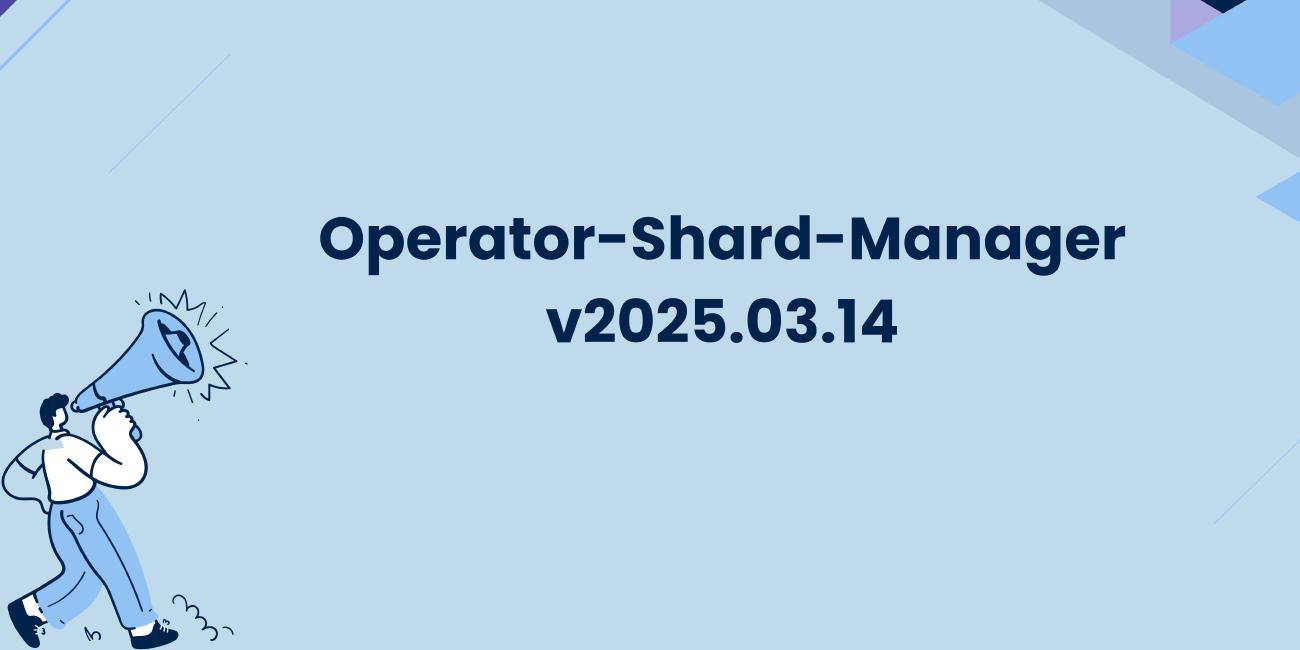
Operator Shard Manager (Introduced in 2025.3.14)
Use Case
The Operator Shard Manager is designed using Consistent Hashing with bounded loads algorithm to efficiently distribute workloads among multiple controller instances. This workload distribution must be stateless.
Lets try to understand how this works.
Installing KubeDB
Let’s assume you have installed kubedb-v2025.3.24 in your Kubernetes cluster. If you haven’t installed it yet, follow the instructions here
.
➤ helm ls -n kubedb
NAME NAMESPACE REVISION UPDATED STATUS CHART APP VERSION
kubedb kubedb 1 2025-03-25 10:25:05.598350871 +0600 +06 Succeeded kubedb-v2025.3.24 v2025.3.24
This confirms that kubedb-v2025.3.24 is installed on the cluster.
Checking Installed StatefulSets
➤ kubectl get sts -n kubedb
NAME READY AGE
kubedb-kubedb-autoscaler 1/1 2d1h
kubedb-kubedb-ops-manager 1/1 2d1h
kubedb-kubedb-provisioner 1/1 2d1h
After installation, three StatefulSets are created along with few deployments and few other resources.
Checking Created Pods
➤ kubectl get pods -n kubedb
kubedb-kubedb-autoscaler-0 1/1 Running 1 (41h ago) 2d1h
kubedb-kubedb-ops-manager-0 1/1 Running 2 (41h ago) 2d1h
kubedb-kubedb-provisioner-0 1/1 Running 1 (41h ago) 41h
kubedb-kubedb-webhook-server-79cf5d496f-c29f7 1/1 Running 1 (41h ago) 2d1h
kubedb-petset-7f4474897b-w5hqg 1/1 Running 1 (41h ago) 2d1h
kubedb-sidekick-78fbd9947c-bw6b2 1/1 Running 1 (41h ago) 2d1h
We can see only single kubedb-kubedb-provisioner-0 pod has been created.
Creating a PostgreSQL Custom Resource for understanding sharding
With KubeDB installed, you can now create a Postgres custom resource to provision a PostgreSQL cluster.
Postgres Custom Resource (CR)
apiVersion: kubedb.com/v1
kind: Postgres
metadata:
name: ha-postgres
namespace: demo
spec:
replicas: 3
storageType: Durable
podTemplate:
spec:
restartPolicy: Always
containers:
- name: postgres
resources:
requests:
cpu: "300m"
memory: "356Mi"
- name: pg-coordinator
resources:
requests:
cpu: "150m"
memory: "100Mi"
storage:
accessModes:
- ReadWriteOnce
resources:
requests:
storage: 7Gi
version: "17.4"
Applying the Custom Resource
➤ kubectl apply -f ha-postgres.yaml
postgres.kubedb.com/ha-postgres created
Checking Created Resources
➤ kubectl get pods,pg,svc,secrets,pvc -n demo
NAME READY STATUS RESTARTS AGE
pod/ha-postgres-0 2/2 Running 0 13m
pod/ha-postgres-1 2/2 Running 0 12m
pod/ha-postgres-2 2/2 Running 0 12m
NAME VERSION STATUS AGE
postgres.kubedb.com/ha-postgres 17.4 Ready 13m
NAME TYPE CLUSTER-IP EXTERNAL-IP PORT(S) AGE
service/ha-postgres ClusterIP 10.43.93.78 <none> 5432/TCP,2379/TCP 13m
service/ha-postgres-pods ClusterIP None <none> 5432/TCP,2380/TCP,2379/TCP 13m
service/ha-postgres-standby ClusterIP 10.43.225.204 <none> 5432/TCP 13m
NAME TYPE DATA AGE
secret/ha-postgres-auth kubernetes.io/basic-auth 2 45h
NAME STATUS VOLUME CAPACITY ACCESS MODES STORAGECLASS VOLUMEATTRIBUTESCLASS AGE
persistentvolumeclaim/data-ha-postgres-0 Bound pvc-95135495-3a9e-469a-9a50-f60d7726c60e 7Gi RWO longhorn <unset> 13m
persistentvolumeclaim/data-ha-postgres-1 Bound pvc-c9c14a21-af97-45da-8ca4-14de70c705c5 7Gi RWO longhorn <unset> 12m
persistentvolumeclaim/data-ha-postgres-2 Bound pvc-a28e95a4-ebb2-4186-b992-c3b157b61074 7Gi RWO longhorn <unset> 12m
As you can see, KubeDB has created multiple resources such as services, PVCs, secrets, and pods.
Why Do We Need Operator Sharding?
Everything works fine when you have a reasonable number of custom resources in your cluster. Like a few hundred Postgres CRs.
But what happens when you have thousands of custom resources?
This is where Operator Sharding becomes essential! Because managing this many resources might be troublesome for a single operator. Also it makes debugging harder if you have this much resources processed by a single operator.
How Operator Sharding Works
Instead of a single provisioner handling all custom resources, Operator Shard Manager distributes the workload among multiple controller pods.
For example, if you scale up the kubedb-kubedb-provisioner StatefulSet:
kubectl scale sts -n kubedb kubedb-kubedb-provisioner --replicas=3
You will get:
kubedb-kubedb-provisioner-0kubedb-kubedb-provisioner-1kubedb-kubedb-provisioner-2
Each of these pods can independently handle different custom resources if you use operator shard manager.
Why Scaling Alone without shard-manager is Not Enough?
If you only scale up the StatefulSet, all the provisioner pods will process the same custom resources in parallel, which can lead to conflicts, inconsistent state, and unnecessary resource consumption.
How Operator Shard Manager Helps
With Operator Shard Manager, each custom resource is assigned to a specific controller pod. This ensures:
- No duplicate processing
- Efficient workload distribution
- Better scalability and reliability
Now, instead of all provisioner pods competing for the same resources, each custom resource is handled by a single assigned controller, ensuring smooth and conflict-free execution.
Enough of talks, lets have some hands on. For that we will need to upgrade the kubedb like below:
helm upgrade -i kubedb oci://ghcr.io/appscode-charts/kubedb \
--version v2025.3.24 \
--namespace kubedb --create-namespace \
--set operator-shard-manager.enabled=true \
--set kubedb-provisioner.replicaCount=3 \
--set-file global.license=license.txt \
--wait --burst-limit=10000 --debug
make sure you change the license.txt with correct license.
--set operator-shard-manager.enabled=truewill install theOperator Shard Managerin your cluster.--set kubedb-provisioner.replicaCount=3will upgrade your cluster with 3 provisioner pods(kubedb-kubedb-provisioner-0,kubedb-kubedb-provisioner-1,kubedb-kubedb-provisioner-2).
Once you are done with the upgrade, you should also get a ShardConfiguration object in your cluster.
➤ kubectl get shardconfiguration kubedb-provisioner -oyaml
apiVersion: operator.k8s.appscode.com/v1alpha1
kind: ShardConfiguration
metadata:
annotations:
meta.helm.sh/release-name: kubedb
meta.helm.sh/release-namespace: kubedb
creationTimestamp: "2025-03-25T04:26:48Z"
generation: 1
labels:
app.kubernetes.io/managed-by: Helm
name: kubedb-provisioner
resourceVersion: "502805"
uid: 0334416e-ea7d-4ed1-b25e-570023ca04a1
spec:
controllers:
- apiGroup: apps
kind: StatefulSet
name: kubedb-kubedb-provisioner
namespace: kubedb
resources:
- apiGroup: kubedb.com
- apiGroup: elasticsearch.kubedb.com
- apiGroup: kafka.kubedb.com
- apiGroup: postgres.kubedb.com
status:
controllers:
- apiGroup: apps
kind: StatefulSet
name: kubedb-kubedb-provisioner
namespace: kubedb
pods:
- kubedb-kubedb-provisioner-0
- kubedb-kubedb-provisioner-1
- kubedb-kubedb-provisioner-2
How Sharding Works
As the installation done, lets figure out how this works.
The ShardConfiguration has two parts in the specification:
- Controllers:
spec.controllers[*]defines which StatefulSets/Deployments/DaemonSets will be managing/processing resources. We will then get the pods that were created by this StatefulSets/Deployments/DaemonSets and update thestatus.controllers. - Resources:
.spec.resourcesdefines which API group (likekubedb.com) objects are sharded.
Example for Postgres (API group: kubedb.com) and kubedb-kubedb-provisioner StatefulSet:
spec:
controllers:
- apiGroup: apps
kind: StatefulSet
name: kubedb-kubedb-provisioner
namespace: kubedb
resources:
- apiGroup: kubedb.com
The status shows which pods are handling resources:
status:
controllers:
- pods:
- kubedb-kubedb-provisioner-0 # Index number 0
- kubedb-kubedb-provisioner-1 # Index number 1
- kubedb-kubedb-provisioner-2 # Index number 2
Sharding in Action
Each resource in the kubedb.com apiGroup gets a label like:shard.operator.k8s.appscode.com/kubedb-provisioner: "X"
where X is the index of the pod handling it.
Example 1: ha-postgres
> kubectl get pg -n demo ha-postgres -oyaml
...
metadata:
labels:
shard.operator.k8s.appscode.com/kubedb-provisioner: "0" ## Index number
...
→ Managed by kubedb-kubedb-provisioner-0 because it has index 0 in .status.controllers[0].pods[0] <- kubedb-kubedb-provisioner-0.
Example 2: tls Postgres
Lets create another Postgres object.
apiVersion: kubedb.com/v1
kind: Postgres
metadata:
name: tls
namespace: demo
spec:
version: "17.4"
replicas: 3
clientAuthMode: "cert"
sslMode: "verify-full"
standbyMode: Hot
storageType: Durable
tls:
issuerRef:
apiGroup: cert-manager.io
kind: Issuer
name: pg-issuer
storage:
accessModes:
- ReadWriteOnce
resources:
requests:
storage: 1Gi
deletionPolicy: WipeOut
Please follow this tutorial to setup a cluster for using tls. Though this is not necessary for this tutorial. Only problem is your
tlsdb will be in provisioning state.
> kubectl apply -f tls.yaml
postgres.kubedb.com/tls created
Now get the yaml:
> kubectl get pg -n demo tls -oyaml
...
metadata:
labels:
shard.operator.k8s.appscode.com/kubedb-provisioner: "1"
...
→ Managed by kubedb-kubedb-provisioner-1 because it has index 1 in .status.controllers[0].pods[1] <- kubedb-kubedb-provisioner-1.
Note: we are talking about index from here
status:
controllers:
- pods:
- kubedb-kubedb-provisioner-0 # Index number 0
- kubedb-kubedb-provisioner-1 # Index number 1
- kubedb-kubedb-provisioner-2 # Index number 2
Lets verify this by checking the logs of kubedb-kubedb-provisioner-0 & kubedb-kubedb-provisioner-1 whether they are processing their respective keys.
➤ kubectl logs -f -n kubedb kubedb-kubedb-provisioner-0
...
I0327 08:30:44.768773 1 postgres.go:392] "validating" logger="postgres-resource" name="ha-postgres" # processing ha-postgres postgres resource of kubedb.com apiGroup
➤ kubectl logs -f -n kubedb kubedb-kubedb-provisioner-1
...
I0327 08:31:46.479722 1 postgres.go:392] "validating" logger="postgres-resource" name="tls" # processing tls postgres resource of kubedb.com apiGroup
I0327 08:31:46.632462 1 reconciler.go:93] Required secrets for postgres: demo/tls are not ready yet
Here you can see, kubedb-kubedb-provisioner-0 is processing ha-postgres key and kubedb-kubedb-provisioner-1 is processing tls key.
Important Note on Sharding and Scaling
Caution: Scaling the sharded StatefulSet/Deployments/Daemonsets (up or down) may trigger resharding, causing resources (like ha-postgres, tls) to be reassigned to different pods.
When to Use Sharding?
Stateless workloads (safe for resharding):
- Example:
kubedb-kubedb-provisioner(no persistent state). - If a resource moves to another pod, it continues working without issues.
Stateful workloads (avoid sharding):
- Example:
kubedb-kubedb-ops-manager(must maintain state until tasks complete). - Resharding could disrupt operations if a resource moves mid-execution.
Best Practice
- Use sharding only for stateless controllers.
- Avoid sharding for stateful controllers that require stable pod assignments.
Support
To speak with us, please leave a message on our website .
To receive product announcements, follow us on Twitter/X .
Learn More about Production-Grade Databases in Kubernetes
If you have found a bug with KubeDB or want to request for new features, please file an issue .









